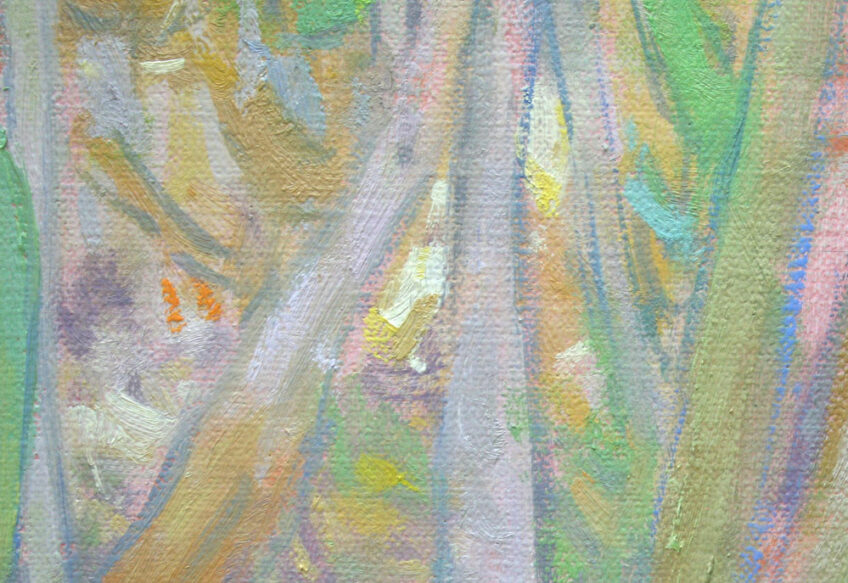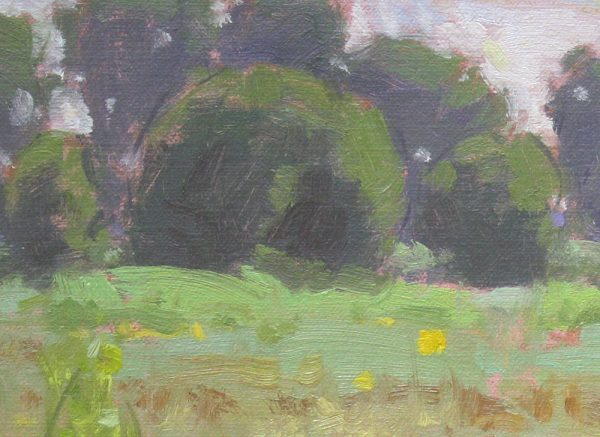As I began my training in painting I remember being told not to worry too much about trying to develop a personal style, but that it would simply take care of itself. This was probably good advice at the time (it allowed me to focus on learning the technical fundamentals—drawing, design, value, color, etc.). But I was led to believe that style was something that could not be controlled—something that was bestowed upon me and would “show up” when I was ready. I do think that is partly true, but I am beginning to believe that certain aspects of style must be thoughtfully considered if I want to experience full satisfaction from my art.
Style in painting refers to a combination of things that can be broken down into three main components. The first component is the artist’s choices regarding how he or she will execute each step of the painting. The technical skill of the artist is the second component (which develops as the artist learns, practices and experiments). The third component of style is the artist’s personal artistic tendencies.
The first two components tend to be closely related. For example, if the artist chooses to paint in the style of Rembrandt but doesn’t know the techniques to achieve it, chances are that he or she will not create a successful painting in that style (without further practice). Regarding the third component of style, you and I each have definite personal artistic tendencies when we paint. These are either tendencies that are related to what we have learned and practiced, or tendencies based on the indefinable qualities that make each of us unique.
We can purposely change tendencies based on things we have been taught, and we should challenge those things to make sure they are the best ways to achieve our painting goals. Suppose I was taught to use only a #4 bristle brush throughout each and every painting. It may prove to be a helpful decision to challenge that teaching by introducing different brush sizes and types in future paintings because of the different effects that can be achieved that were not possible with a #4 bristle brush. It might open up a whole new world of possibilities that will bring me more and more satisfaction with my paintings.
If we desire, we can also choose to change tendencies that are related to our own unique qualities. I might love to apply paint with little dabs throughout my paintings, but choose to change my approach and begin to paint with smooth glazes because so-and-so is doing it (and getting lots of attention for it). I am free to make that choice, but I must decide if I am still being true to my individual tendencies; to who I am as an artist. Chances are that I’m not.
Let us imagine that we were able to challenge any artist we would consider a “master” to paint in the same style as another artist. I think that the master would be able to replicate the given style (at least eventually) because of his or her wealth of knowledge, experience and technical skill. But the reason master artists paint the way they do is that they have found their favorite way to paint and they have mastered it. From subject matter to technique, they paint what and how they love to paint. Of course, masters may choose to employ specific aspects of different styles when the need arises, but they still strive to be true to who they are.
I believe that we, too, must discover our favorite way to perform each step of our personal art process if we are to develop our true styles. We should make choices in our working methods that will bring us greater satisfaction, but be careful to be faithful to our unique personal tendencies. The result will be the development of our true personal styles as we continue to learn, experiment and explore this artistic adventure.
Leave a comment and let me know your thoughts.


22 Responses
Joanne Hanson
I came to your blog post through one that Stacey Peterson wrote about it and found it very interesting! Thanks for sharing. It is interesting how we all seem to have our own signature without even signing the painting.
Dan Schultz
Thanks for your comment, Joanne! I’m glad you enjoyed the article.
Kevin Courter
Dan, couldn’t agree with you more. Thanks. If you don’t mind I’d like to place a link from your blog to my own at kevincourter.wordpress.com.
Cheers, Kevin
Sheila Vaughan
Dan, what a refreshingly succinct way of putting it! Of course, it’s discovering what is our “favourite” way to paint both in terms of choice of subject and choice of application. I think it takes several years very often for people to settle in to what really is their favourite way of working. I find I go round in circles a bit but that is enlightening to me. I find myself moving back to subjects and techniques I was using one or more years ago. You have to ask yourself “why – why am I doing that”. I said your comment was refreshing because so much has been written on the blogs on this subject and I have been guilty of it myself on more than one occasion but I have never seen that simple truth presented. Thank you!
Dan Schultz
Thanks for your comments, Kevin and Sheila. Kevin, I put a link to your blog on my links page — does that work for you? Sheila, I’m glad you found my post helpful. I seem to be going back and forth a bit with my style as well. I guess it’s just all part of the process.
canvas artwork
This blog discovering what is most efficient way to paint choice of subject and choice of application, i think it is very difficult to find out the most favorite topic.
thanks for giving such a interesting blog.
Plein Air Painting Dan Schultz Fine Art
[…] the way, I regularly talk to people who mistakenly think that plein air painting is a particular style of painting. While some plein air paintings can have definite similarities, they are due to the fact that the […]
JR. Monks
Dan I remember painting with you at the Garden of the Gods and you commented I had a particular manner of painting trees, your article resonates. In the sea of technically accomplished landscape artist I think it is the little things that distinguish us.
Helen Pernicone
Thank you Dan for helping me during a particularly insecure time! I feel as though I don’t know enough technical aspects of painting to even think of my personal style. YET, when I look at all of my work, I see a unique style-not quite sure I embrace it though. I would like to paint more “painterly” and I am hoping that with more knowledge and practice I will be able to get there.
Dan Schultz
Thanks for the comments, J.R. and Helen. I’m glad the article resonates with you!
Patti Vincent
Hi Dan, Thank you for writing useful and thought provoking posts. My BFA painting instructor recently asked the class to define style in a group discussion and no one had a very good answer. I am going to share this with my professor and class. I also Pinned it! Thanks again, Patti
Dan Schultz
Thanks for sharing my article, Patti — I hope it’s good enough for your class!
Rebecca Windinwood
Dan, you put the FUN back into painting for me. When I view your work or read your words, I feel reinvigorated to try my hand at painting again. Thank you!
Dan Schultz
Thanks, Rebecca — glad to help inspire you!
Gayle Martin
Hi Dan. Thank you for your article. It was encouraging and informative. I appreciate that you share your knowledge. I look forward to painting with you again.
Trent Gudmundsen
Well said, Dan. Glad you republished this article. I like what you said about challenging learned techniques. Recently I “committed” to painting for at least several weeks with a super-limited palette, and I learned so much by doing so; but also was able to rediscover how my other colors can be of benefit as well. It’s fun to push the limits beyond what I think necessary or familiar. I feel like it helps us re-evaluate and re-define what our natural tendencies are as artists. (By the way, your stylistic choices and tendencies are really unique and enjoyable). Take care. -Trent
Dan Schultz
Thanks so much for your nice comment, Trent — great to hear from you! Glad you’re enjoying your limited palette paintings — such a great way of simplifying things.
Liz Todd
Hi Dan, Thank you for sharing these insights. The timing is perfect, as I feel the need to explore new technique and style. Hope to see you in Sonoma, and look forward to painting with you soon in Ojai. And – congratulations on the sale of your painting in Steamboat Springs : )
Liz
Dan Schultz
Looking forward to seeing you too, Liz. Yes I was pleased to hear about the sale in Steamboat!
Joann M. Douk
Your article may be over 10 years old but it has been very helpful for me. I began painting acrylics (again) when I moved to Ojai about 3 years ago, taking classes from several of the artists there. All of your articles I’ve read so far really resonate with me, especially as I continue to try new mediums and find my artistic voice. You’ve inspired me to try oil painting and especially plein air painting. I look forward to attending ANY of your classes or demonstrations in 2022. Thanks again, for all your valuable tips and ongoing encouragement.
Dan Schultz
So glad you’ve found my posts helpful, Joann. Happy painting!
Joquim
You made some excellent points about the importance of experimenting with different techniques and finding your unique voice. I’m particularly intrigued by the way you emphasized the role of inspiration from various sources. For me, blending traditional methods with contemporary techniques has been a game-changer in my own artistic journey. It’s fascinating to see how different influences can come together to create something truly original.